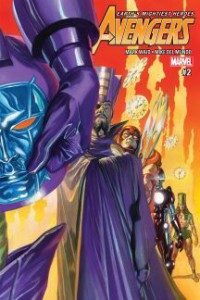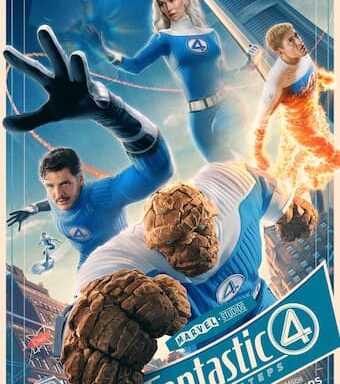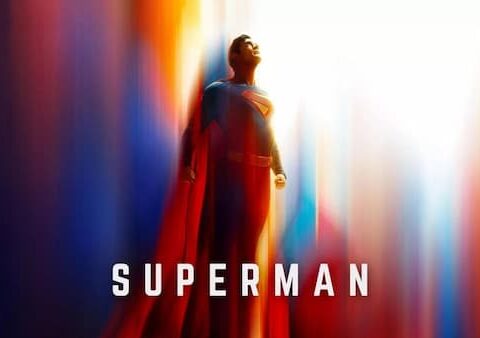The most striking, compelling thing about this current iteration of The Avengers is Mike Del Mundo‘s distinctive art work.
There is such a uniquely off-kilter, surrealist quality to how Del Mundo draws and colors scenes that it is the primary thing you find yourself absorbing from the books.
I once had it put to me quite convincingly that the best art in comic books is the art you don’t notice – the art that is so seamless that, in its inconspicuousness, it doesn’t draw your attention away from the storytelling.
But, looking at Del Mundo’s work, it becomes more difficult to hold to that idea.
The scratchy quality to the visuals, and the way he renders shade and diffuses background, amid other things, makes it difficult to take your eye off the visual experience and focus on the dialogue or the plot.
The full page image on page 24 (Avengers #1) – of Kang and Vision confronting each other in mid-air – is a really good example of how compelling his techniques can be. The way the buildings in the background, and even the civilians below, are slightly blurred and out of focus, while the focal point of Kang and Vision is so vivid.
Some characters in particular benefit tremendously from Del Mundo’s style of rendering; particularly Thor and Vision, though even Spiderman looks pretty great in Del Mundo’s hands.
The art notwithstanding, this book raised questions from the start for me about whether this is a good enough line-up for a lead Avengers book.
I’m a little bored of Sam Wilson, though I get why he needs to be here. I’m always happy with Vision, and adding Spiderman and the new Wasp to the team is definitely helpful, though I’m not sure bringing Hercules into this mix is necessarily the best move. With Thor already there, adding in another mythic god with Shakespearean tendencies might be a redundancy.
I guess we’ll have to see how this line-up fares.
Story wise, Mark Waid gets us off on sure footing by bringing in Kang the Conqueror – you can’t really go wrong with Kang. Kang has been one of my all-time favorite characters for a long time, and his arrival – just as I was starting to get a little bored of Avengers #1 – immediately re-energised my interest levels.
Del Mundo also renders Kang beautifully, and all of the visuals here with the Kang confrontation and all of the time-travel sequences, are superbly interpreted.
I’m also a sucker for time travel, temporal paradoxes and alternate timelines, which we’re getting plenty of here.
The big reveal here is Vision’s admission that he has himself time-travelled in order to kidnap an infant Kang and prevent him from ever becoming the menace we all know. His well-meaning actions haven’t yielded the results he was aiming for, however, and Kang (who, as Vision says, “traffics in paradoxes”) couldn’t be eliminated that easily.
Avengers #1 is a solid first chapter, doing what good opening chapters should do – establishing some intrigue and motivation and providing an immediate sense of the stakes.
While I still think a few better characters could’ve been put into this line-up, this present roster could do alright with strong storytelling. It will help, of course, that Del Mundo’s distinctive visuals continue to hold the book up to a higher standard of enjoyment than would otherwise be accomplished by the story or writing alone.
The cover to Avengers #2 is an all-time classic and perfectly encapsulates why Kang is such an immutable, great villain. The cover shows Kang in iterations from different epochs, standing in a row, each of them rendered with stunning texture and detail by Del Mundo. The sense of perspective and scope is stunning and this cover art alone would make me want to buy the book even if I wasn’t interested in the story.
Thankfully for me, I was intrigued enough by the set-up from Avengers #1.
The plot mechanics and ideas driving this story can be a bit of a headache on first reading. But the paradoxes and temporal confusions that usually accompany a Kang storyline usually have this effect. We start here with the Avengers team trapped in limbo – having been put there by a future version of Kang to save their lives after ‘our’ (Prime) Kang went back in time and killed each of the characters as infants.
This doesn’t last very long, however.
Admittedly, the way the heroes get out of this limbo and are able to find and confront Kang reeks a little of convenience and is rather glossed over in the writing; likewise, Vision suddenly being able to send Wasp to the exact point in the past where the infant Kang was kidnapped from also reeks of convenient plot-device.
Most of what happens in Avengers #2 feels like a story being rushed unnecessarily, and with plot devices and contrived elements being moved about instead of a story flowing from characters or at a natural pace.
I still like the general premise – specifically, of Vision setting off temporal paradoxes by interfering with Kang’s infancy. But Avengers #2 just doesn’t boast any great storytelling and, instead, feels like a by-the-numbers exercise.
Avengers #3 broadly offers more of the same.
Some interesting thoughts, themes and ideas, but still generally feeling like a by-the-numbers exercise in storytelling terms. It is really Del Mundo’s art work that is carrying the book at this point.
Wasp/Nadia gets reasonably good page-time here and Spiderman gets a few good lines in; but, really, the conclusion (of sorts) to this arc mostly had me hoping the series gets a lot better as it goes on.
Avengers #4 is a complete change, with an issue entirely devoted to Kang the Conqueror – and told entirely from Kang’s perspective. From beginning to end, I absolutely loved this issue.
It helps that I’m such a fan of the character, otherwise this might’ve been too much. Conceptually, it’s a terrific interlude – an entire book consisting of Kang’s own monologue, as he recounts his history, motivations and psychology, with the whole mythology updated to bring our understanding of Kang into place with this current story arc.
For younger readers, perhaps, unfamiliar with Kang’s mythology, this is a useful study; for the rest of us, we can enjoy how refreshed and reinvigorated this mythology is by Del Mundo’s stunning, gripping artwork. Those illustrations that accompany and give life to Kang’s history here are breathtaking.
This book is a visual feast from page to page and panel to panel.
Any time I think of Kang’s mythology now, I am liable to immediately envision Del Mundo’s art here. From stunning montages and spreads to depict Kang’s temporal adventures, to Dali-esque depictions of time-travel motifs and a gorgeous depiction of Kang’s ‘Rama Tut’ phase (which, brilliantly, has Kang/Rama-Tut on his throne, against a background of Egyptian hieroglyphics and wall paintings depicting his story), this book is a visual masterpiece.

It probably aids Del Mundo that this book follows a simple, singular narrative – a recounting of history from the perspective of one character – that allows the artist to really go to town and express himself in a way that feels operatic.
Kang’s monologue is also fascinating, running like a poem throughout the book; but it’s really the visuals that elevate this book and I found myself re-reading it three times in one day, just to adore the visual experience.
Rather beautifully, it also ends at the point where Avengers #5 will later reach – except here we’re seeing the moment from Kang’s perspective, while in Avengers #5 we see the same point from the Avengers’ perspective. It’s very clever, very pleasing, storytelling and creative planning.
I can’t recommend Avengers #4 enough – it is a stunning interlude of vivid tone and visual poetry.
Avengers #5 suffers a tad from feeling gimmicky; on the other hand, it also feels like classic, very old-school storytelling and it packs a reasonable nostalgia punch.
I’m generally liking the idea of Vision as time-traveller and the sense of him almost becoming like a version of Kang. Vision’s aloof AI nature does lend itself to that kind of evolution and seems to bear the seeds of future demagoguery, even if, for now, he’s still acting as one of the good guys.
The current Avengers fetching classic Avengers from other points in time to help confront Kang does feel too gimmicky and perhaps a little false. But it kind of works as a dose of surrealist sci-fi, even if it was only really done for the nostalgia element. This is arguably the problem with time-travel stories though – when you do time-travel stories so often that you become jaded about the concept of timeline manipulation and interference in the past, everything tends to become cavalier and to feel way too casual.
That being said, it is genuinely fun to see past Avengers interacting with current Avengers and going on missions together; particularly the interactions between classic Hulk and modern Spidey and the encounter between past Thor and current (lady) Thor. This is nostalgia that generally works; I even got the feels seeing old-school Wasp (Jan) and old-school Goliath in action again.
And it also works well having these different characters from different times divide into different little teams with our contemporary characters and go off on different – though related – missions.
More importantly, it soon transpires that this nostalgia overload isn’t just for our gratification, but builds to a major plot turn. Specifically, the possibility that, via some vague, temporal technobabble plot-detail, the original, founding Avengers might be wiped from history.
Admittedly, while the threat – or the possibility – feels perilous and compelling, the temporal mechanics of it tend to fall into vague, comic-book-speak territory; suggesting that this is one of those occasions where we simply have to refrain from over-analysing or assessing the science logic and just go with the flow for the sake of the dramatic rewards. I mean, creatures that ‘steal futures’ is just so silly – but the erasure of the founding Avengers is, at the same time, a compelling premise.
So… you know, pros and cons.
In other words, I’m not sure whether all this temporal babble holds up or not – but, dammit, I’m engaged by the threat of the original Avengers being removed from history!
Captain America’s late realisation that his team has been trapped in an impossible situation is compelling too – literally, they’ve been cornered by the one person in the past that they can’t kill, because doing so will alter the timeline and rewrite the future from which they were brought back. That person is Kang, by the way (as if you didn’t know). It’s a good cliffhanger; and Kang gets a suitably dramatic entrance.
Kang always gets a suitably dramatic entrance. In fact, there’s probably no one in comics who gets so many suitably dramatic entrance scenes – Kang knows how to announce himself, that’s for sure.
The characters by this point are all effortlessly enjoyable; stunningly rendered, well written and full of wit. Nadia is continuing to develop quickly into a major and welcome presence, while Spiderman continues to bring his unique brand of energy to the party.
There are some fun moments scattered about here; chief among them being Sam’s little time paradox of accidentally shouting “Avengers Assemble” and therefore becoming the person who introduced that battle-cry to the original Avengers.
Avengers #6 is essentially precisely the same in all respects. Good moments scattered about, fun dynamics and witty dialogue, brilliant art – but more techno-babble overload that may or may not hold up and, in general, an over-burdened story that may or may not make sense and may or may not be worth all the trouble.
I can’t really decide.
It’s fun to read. There’s a definite nostalgia element that works. As a plot though, I’m not sure any of this scales particularly great heights or was even necessary.
This has proven an enjoyable book though. Not as continuously enticing as, say, the Uncanny Avengers title has proven to be – but still worth the monthly effort. The artwork alone is worth the price of admission.




